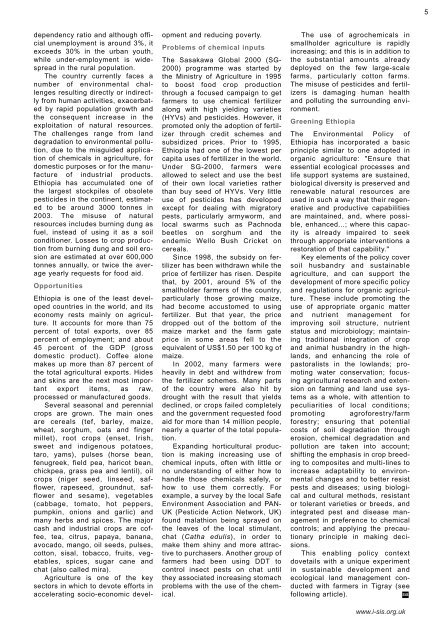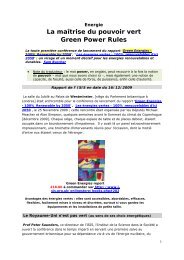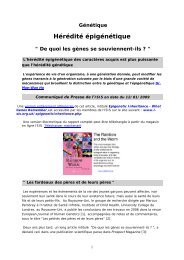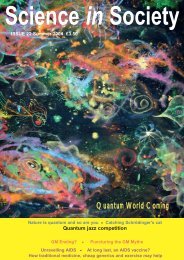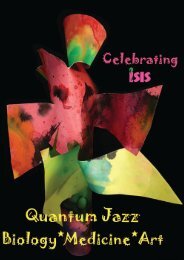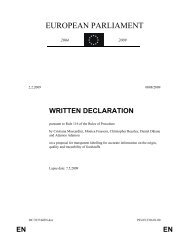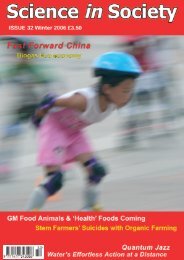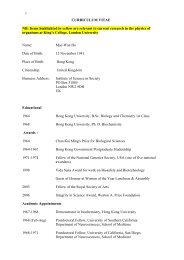Ethiopia goes organic to feed herself - The Institute of Science In ...
Ethiopia goes organic to feed herself - The Institute of Science In ...
Ethiopia goes organic to feed herself - The Institute of Science In ...
Create successful ePaper yourself
Turn your PDF publications into a flip-book with our unique Google optimized e-Paper software.
5<br />
dependency ratio and although <strong>of</strong>ficial<br />
unemployment is around 3%, it<br />
exceeds 30% in the urban youth,<br />
while under-employment is widespread<br />
in the rural population.<br />
<strong>The</strong> country currently faces a<br />
number <strong>of</strong> environmental challenges<br />
resulting directly or indirectly<br />
from human activities, exacerbated<br />
by rapid population growth and<br />
the consequent increase in the<br />
exploitation <strong>of</strong> natural resources.<br />
<strong>The</strong> challenges range from land<br />
degradation <strong>to</strong> environmental pollution,<br />
due <strong>to</strong> the misguided application<br />
<strong>of</strong> chemicals in agriculture, for<br />
domestic purposes or for the manufacture<br />
<strong>of</strong> industrial products.<br />
<strong>Ethiopia</strong> has accumulated one <strong>of</strong><br />
the largest s<strong>to</strong>ckpiles <strong>of</strong> obsolete<br />
pesticides in the continent, estimated<br />
<strong>to</strong> be around 3000 <strong>to</strong>nnes in<br />
2003. <strong>The</strong> misuse <strong>of</strong> natural<br />
resources includes burning dung as<br />
fuel, instead <strong>of</strong> using it as a soil<br />
conditioner. Losses <strong>to</strong> crop production<br />
from burning dung and soil erosion<br />
are estimated at over 600,000<br />
<strong>to</strong>nnes annually, or twice the average<br />
yearly requests for food aid.<br />
Opportunities<br />
<strong>Ethiopia</strong> is one <strong>of</strong> the least developed<br />
countries in the world, and its<br />
economy rests mainly on agriculture.<br />
It accounts for more than 75<br />
percent <strong>of</strong> <strong>to</strong>tal exports, over 85<br />
percent <strong>of</strong> employment; and about<br />
45 percent <strong>of</strong> the GDP (gross<br />
domestic product). C<strong>of</strong>fee alone<br />
makes up more than 87 percent <strong>of</strong><br />
the <strong>to</strong>tal agricultural exports. Hides<br />
and skins are the next most important<br />
export items, as raw,<br />
processed or manufactured goods.<br />
Several seasonal and perennial<br />
crops are grown. <strong>The</strong> main ones<br />
are cereals (tef, barley, maize,<br />
wheat, sorghum, oats and finger<br />
millet), root crops (enset, Irish,<br />
sweet and indigenous pota<strong>to</strong>es,<br />
taro, yams), pulses (horse bean,<br />
fenugreek, field pea, haricot bean,<br />
chickpea, grass pea and lentil), oil<br />
crops (niger seed, linseed, safflower,<br />
rapeseed, groundnut, safflower<br />
and sesame), vegetables<br />
(cabbage, <strong>to</strong>ma<strong>to</strong>, hot peppers,<br />
pumpkin, onions and garlic) and<br />
many herbs and spices. <strong>The</strong> major<br />
cash and industrial crops are c<strong>of</strong>fee,<br />
tea, citrus, papaya, banana,<br />
avocado, mango, oil seeds, pulses,<br />
cot<strong>to</strong>n, sisal, <strong>to</strong>bacco, fruits, vegetables,<br />
spices, sugar cane and<br />
chat (also called mira).<br />
Agriculture is one <strong>of</strong> the key<br />
sec<strong>to</strong>rs in which <strong>to</strong> devote efforts in<br />
accelerating socio-economic development<br />
and reducing poverty.<br />
Problems <strong>of</strong> chemical inputs<br />
<strong>The</strong> Sasakawa Global 2000 (SG-<br />
2000) programme was started by<br />
the Ministry <strong>of</strong> Agriculture in 1995<br />
<strong>to</strong> boost food crop production<br />
through a focused campaign <strong>to</strong> get<br />
farmers <strong>to</strong> use chemical fertilizer<br />
along with high yielding varieties<br />
(HYVs) and pesticides. However, it<br />
promoted only the adoption <strong>of</strong> fertilizer<br />
through credit schemes and<br />
subsidized prices. Prior <strong>to</strong> 1995,<br />
<strong>Ethiopia</strong> had one <strong>of</strong> the lowest per<br />
capita uses <strong>of</strong> fertilizer in the world.<br />
Under SG-2000, farmers were<br />
allowed <strong>to</strong> select and use the best<br />
<strong>of</strong> their own local varieties rather<br />
than buy seed <strong>of</strong> HYVs. Very little<br />
use <strong>of</strong> pesticides has developed<br />
except for dealing with migra<strong>to</strong>ry<br />
pests, particularly armyworm, and<br />
local swarms such as Pachnoda<br />
beetles on sorghum and the<br />
endemic Wello Bush Cricket on<br />
cereals.<br />
Since 1998, the subsidy on fertilizer<br />
has been withdrawn while the<br />
price <strong>of</strong> fertilizer has risen. Despite<br />
that, by 2001, around 5% <strong>of</strong> the<br />
smallholder farmers <strong>of</strong> the country,<br />
particularly those growing maize,<br />
had become accus<strong>to</strong>med <strong>to</strong> using<br />
fertilizer. But that year, the price<br />
dropped out <strong>of</strong> the bot<strong>to</strong>m <strong>of</strong> the<br />
maize market and the farm gate<br />
price in some areas fell <strong>to</strong> the<br />
equivalent <strong>of</strong> US$1.50 per 100 kg <strong>of</strong><br />
maize.<br />
<strong>In</strong> 2002, many farmers were<br />
heavily in debt and withdrew from<br />
the fertilizer schemes. Many parts<br />
<strong>of</strong> the country were also hit by<br />
drought with the result that yields<br />
declined, or crops failed completely<br />
and the government requested food<br />
aid for more than 14 million people,<br />
nearly a quarter <strong>of</strong> the <strong>to</strong>tal population.<br />
Expanding horticultural production<br />
is making increasing use <strong>of</strong><br />
chemical inputs, <strong>of</strong>ten with little or<br />
no understanding <strong>of</strong> either how <strong>to</strong><br />
handle those chemicals safely, or<br />
how <strong>to</strong> use them correctly. For<br />
example, a survey by the local Safe<br />
Environment Association and PAN-<br />
UK (Pesticide Action Network, UK)<br />
found malathion being sprayed on<br />
the leaves <strong>of</strong> the local stimulant,<br />
chat (Catha edulis), in order <strong>to</strong><br />
make them shiny and more attractive<br />
<strong>to</strong> purchasers. Another group <strong>of</strong><br />
farmers had been using DDT <strong>to</strong><br />
control insect pests on chat until<br />
they associated increasing s<strong>to</strong>mach<br />
problems with the use <strong>of</strong> the chemical.<br />
<strong>The</strong> use <strong>of</strong> agrochemicals in<br />
smallholder agriculture is rapidly<br />
increasing; and this is in addition <strong>to</strong><br />
the substantial amounts already<br />
deployed on the few large-scale<br />
farms, particularly cot<strong>to</strong>n farms.<br />
<strong>The</strong> misuse <strong>of</strong> pesticides and fertilizers<br />
is damaging human health<br />
and polluting the surrounding environment.<br />
Greening <strong>Ethiopia</strong><br />
<strong>The</strong> Environmental Policy <strong>of</strong><br />
<strong>Ethiopia</strong> has incorporated a basic<br />
principle similar <strong>to</strong> one adopted in<br />
<strong>organic</strong> agriculture: "Ensure that<br />
essential ecological processes and<br />
life support systems are sustained,<br />
biological diversity is preserved and<br />
renewable natural resources are<br />
used in such a way that their regenerative<br />
and productive capabilities<br />
are maintained, and, where possible,<br />
enhanced...; where this capacity<br />
is already impaired <strong>to</strong> seek<br />
through appropriate interventions a<br />
res<strong>to</strong>ration <strong>of</strong> that capability."<br />
Key elements <strong>of</strong> the policy cover<br />
soil husbandry and sustainable<br />
agriculture, and can support the<br />
development <strong>of</strong> more specific policy<br />
and regulations for <strong>organic</strong> agriculture.<br />
<strong>The</strong>se include promoting the<br />
use <strong>of</strong> appropriate <strong>organic</strong> matter<br />
and nutrient management for<br />
improving soil structure, nutrient<br />
status and microbiology; maintaining<br />
traditional integration <strong>of</strong> crop<br />
and animal husbandry in the highlands,<br />
and enhancing the role <strong>of</strong><br />
pas<strong>to</strong>ralists in the lowlands; promoting<br />
water conservation; focusing<br />
agricultural research and extension<br />
on farming and land use systems<br />
as a whole, with attention <strong>to</strong><br />
peculiarities <strong>of</strong> local conditions;<br />
promoting agr<strong>of</strong>orestry/farm<br />
forestry; ensuring that potential<br />
costs <strong>of</strong> soil degradation through<br />
erosion, chemical degradation and<br />
pollution are taken in<strong>to</strong> account;<br />
shifting the emphasis in crop breeding<br />
<strong>to</strong> composites and multi-lines <strong>to</strong><br />
increase adaptability <strong>to</strong> environmental<br />
changes and <strong>to</strong> better resist<br />
pests and diseases; using biological<br />
and cultural methods, resistant<br />
or <strong>to</strong>lerant varieties or breeds, and<br />
integrated pest and disease management<br />
in preference <strong>to</strong> chemical<br />
controls; and applying the precautionary<br />
principle in making decisions.<br />
This enabling policy context<br />
dovetails with a unique experiment<br />
in sustainable development and<br />
ecological land management conducted<br />
with farmers in Tigray (see<br />
following article).<br />
SiS<br />
www.i-sis.org.uk


